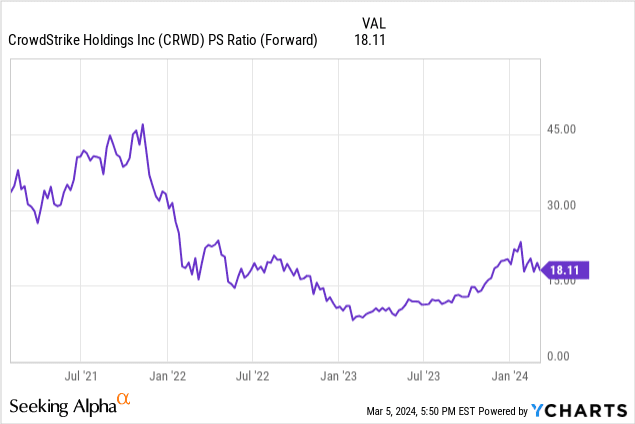Targeting HPV 6 and 11: PRGN-2012 for Recurrent Respiratory Papillomatosis
March 20, 2024 | by stockcoin.net


Precigen, Inc. recently held its Q4 2023 earnings call, providing updates on its lead asset PRGN-2012. This innovative therapy, developed using Precigen’s AdenoVerse platform, targets cells infected with HPV 6 and 11 in patients with Recurrent Respiratory Papillomatosis (RRP), a rare disease characterized by benign tumors in the vocal cord or trachea. Promising Phase 1 trial results demonstrated the safety and efficacy of PRGN-2012, with significant reductions in the number of surgeries required for RRP patients. Based on these findings, the FDA granted Precigen a breakthrough designation and an accelerated path, allowing for the submission of a Biologics License Application (BLA). Precigen’s commitment to advancing therapies for rare diseases is further exemplified by their ongoing development of PRGN-2009, targeted at HPV-related cancers. With its AdenoVerse platform offering differentiation, efficacy, and ease of administration, Precigen is positioned as a frontrunner in the treatment of these complex conditions.
About Precigen, Inc.
Overview
Precigen, Inc. is a biopharmaceutical company focused on developing innovative gene and cell therapies to address unmet medical needs. With a strong emphasis on rare diseases, Precigen combines groundbreaking science with advanced technology to create transformative treatment options. The company’s mission is to improve the lives of patients by providing effective, safe, and accessible therapies.
AdenoVerse platform
Precigen’s AdenoVerse platform is at the forefront of the company’s innovative approach to gene and cell therapy. The platform utilizes gorilla adenovectors, which offer several advantages over traditional vectors. Gorilla adenovectors have a high capacity for genetic material, allowing for the delivery of larger and more complex payloads. Additionally, they do not cause preexisting immunity in humans, providing a significant advantage for patients who may have been previously exposed to adenoviruses.
The AdenoVerse platform enables precise targeting of specific cells and tissues, maximizing therapeutic efficacy while minimizing off-target effects. This differentiation sets Precigen apart from other gene therapy companies, positioning them as leaders in the field.
Lead asset PRGN-2012
PRGN-2012 is Precigen’s lead asset and is currently in development for the treatment of Recurrent Respiratory Papillomatosis (RRP). RRP is a rare disease characterized by the formation of benign tumors in the vocal cords or trachea. These tumors are caused by infection with human papillomavirus (HPV) types 6 and 11.
PRGN-2012 is designed to target cells infected with HPV 6 and 11, delivering a therapeutic payload directly to the affected tissues. The therapy aims to reduce the tumor burden and improve patient outcomes. Results from a Phase 1 trial have shown promising safety data and a significant reduction in the number of surgeries required for RRP patients.
Overview of Recurrent Respiratory Papillomatosis (RRP)
Definition
Recurrent Respiratory Papillomatosis (RRP) is a rare disease characterized by the development of benign tumors in the respiratory tract, specifically in the vocal cords or trachea. These tumors are caused by infection with human papillomavirus (HPV) types 6 and 11. RRP is a chronic condition that requires ongoing treatment and management.
Prevalence
RRP is considered a rare disease, with an estimated prevalence of 2 to 4 cases per 100,000 individuals in the United States. It can affect individuals of all ages, but it is most commonly diagnosed in children and adolescents. The exact cause of RRP is not fully understood, but it is believed to be related to HPV infection and potential genetic factors.
Symptoms
The symptoms of RRP can vary depending on the location and size of the tumors. Common symptoms include hoarseness, difficulty breathing, changes in voice quality, and chronic cough. Severe cases of RRP can lead to airway obstruction and require frequent surgical interventions to remove the tumors. The impact of RRP on patients’ quality of life can be significant, affecting speech, breathing, and overall respiratory function.
HPV 6 and 11 in RRP
Role of HPV 6 and 11
HPV types 6 and 11 have been identified as the primary causative agents of RRP. These viruses are sexually transmitted and can infect the respiratory tract, leading to the development of benign tumors in the vocal cords or trachea. HPV 6 and 11 are classified as low-risk strains, meaning they have a low potential to progress to malignant tumors. However, they can still cause significant morbidity and require ongoing treatment and management.
Impact on RRP patients’ vocal cords or trachea
The presence of HPV 6 and 11 in RRP patients’ respiratory tract has a profound impact on the vocal cords or trachea. The development of tumors in these delicate structures can lead to hoarseness, difficulty speaking, breathing difficulties, and chronic cough. The recurrent nature of RRP, combined with the potential for tumor growth and airway obstruction, necessitates frequent surgical interventions to maintain airway patency and preserve vocal function.
Phase 1 Trial of PRGN-2012
Objective
The objective of the Phase 1 trial for PRGN-2012 was to assess its safety and tolerability in RRP patients. The trial aimed to determine the optimal dose and evaluate any adverse events associated with the treatment. Additionally, the trial aimed to assess the preliminary efficacy of PRGN-2012, including reductions in tumor burden and the need for surgical interventions.
Safety results
Results from the Phase 1 trial demonstrated favorable safety data for PRGN-2012. The therapy was well-tolerated, with no serious adverse events reported. The most common side effects were mild and transient, including local injection site reactions and flu-like symptoms. These safety findings support the continued development of PRGN-2012 as a potential treatment option for RRP patients.
Reduction in surgeries required
One of the key findings from the Phase 1 trial was a significant reduction in the number of surgeries required for RRP patients treated with PRGN-2012. This reduction in surgical interventions is a promising outcome, as it suggests that PRGN-2012 has the potential to decrease the clinical burden of RRP and improve patient quality of life. Further evaluation in larger patient populations is warranted to confirm these findings.
Breakthrough Designation and Accelerated BLA Path
FDA recognition of PRGN-2012
Based on the positive results from the Phase 1 trial and ongoing Phase 2 data, the U.S. Food and Drug Administration (FDA) has granted Precigen a breakthrough designation for PRGN-2012. This designation recognizes the potential of PRGN-2012 to provide a significant improvement over existing therapies for RRP. It also highlights the FDA’s commitment to expediting the development and review process for innovative therapies addressing unmet medical needs.
Benefits of breakthrough designation
The breakthrough designation for PRGN-2012 provides several benefits for Precigen. It enables increased interaction and guidance from the FDA, facilitating a more efficient development process. Additionally, it allows for an accelerated review of the Biologics License Application (BLA) for PRGN-2012, potentially expediting the availability of the therapy to patients in need. Overall, the breakthrough designation supports Precigen’s commitment to rapidly advancing innovative treatments for rare diseases.
Phase 2 Data for PRGN-2012
Expected release date
Precigen plans to present Phase 2 data for PRGN-2012 in the second quarter of 2024. This eagerly anticipated data will provide further insights into the safety and efficacy of PRGN-2012 in a larger patient population. The Phase 2 data will contribute to the overall understanding of PRGN-2012 as a potential treatment option for RRP patients.
Key findings
The Phase 2 data for PRGN-2012 are expected to shed light on its efficacy in reducing tumor burden and improving patient outcomes. The data will also provide additional safety information, further supporting the favorable safety profile observed in the Phase 1 trial. Effective reduction in tumor burden and a decrease in the need for surgical interventions would position PRGN-2012 as a promising therapy for RRP patients.
Biologics License Application (BLA) Submission
Timeline
Following the presentation of Phase 2 data, Precigen plans to submit a Biologics License Application (BLA) in the second half of 2024. The BLA is a comprehensive submission to the FDA, providing detailed information about the safety, efficacy, and manufacturing processes of PRGN-2012. The BLA submission represents a major milestone in the regulatory pathway towards potential approval and commercialization of PRGN-2012.
Process
The BLA submission process involves a thorough review by the FDA, including evaluation of the clinical data, manufacturing processes, and quality control measures. The FDA assesses the benefit-risk profile of the therapy and ensures compliance with regulatory requirements. The review process can take several months to complete, during which the FDA may request additional information or clarification. Precigen will work closely with the FDA throughout this process to address any inquiries and expedite the review.
Expected approval
Pending a successful BLA submission, Precigen anticipates potential approval of PRGN-2012 by the FDA. Approval would signify the recognition of PRGN-2012 as a safe and effective therapy for RRP patients. It would allow for the commercialization of PRGN-2012, making it available to healthcare providers and patients in need. The approval of PRGN-2012 would be a significant achievement in advancing the treatment options for individuals with RRP.
Advancement of PRGN-2009 for HPV 16 and 18 Cancers
Targeted cancers
In addition to developing PRGN-2012 for RRP, Precigen is advancing another molecule, PRGN-2009, for the treatment of HPV 16 and 18 cancers. These high-risk strains of HPV are associated with head and neck cancers and cervical cancer. PRGN-2009 aims to provide a targeted therapy for these specific cancers, addressing the unmet medical needs of patients with limited treatment options.
Clinical studies
Clinical studies for PRGN-2009 are currently ongoing, evaluating its safety and efficacy in patients with HPV-related cancers. These studies involve a comprehensive assessment of PRGN-2009’s therapeutic potential, including tumor response rates, progression-free survival, and overall survival. Early data from these studies has shown promising objective response rates, indicating the potential of PRGN-2009 as an effective treatment option for HPV 16 and 18 cancers.
Promising objective response rates
Objective response rates are a key measure of a therapy’s efficacy in clinical trials. The early data for PRGN-2009 in HPV 16 and 18 cancers has demonstrated promising objective response rates, indicating that the therapy is having a positive effect on reducing tumor burden. These encouraging results provide a strong rationale for further development and evaluation of PRGN-2009 as a potential treatment option for patients with HPV-related cancers.
Potential of Precigen’s AdenoVerse Platform
Differentiation
Precigen’s AdenoVerse platform offers a differentiated viral platform for the development of gene and cell therapies. The utilization of gorilla adenovectors provides several advantages over traditional vectors, including increased payload capacity and reduced risk of preexisting immunity in humans. These differentiating features allow for precise targeting of specific cells and tissues, enhancing the therapeutic potential and minimizing off-target effects.
Efficacy
The AdenoVerse platform has demonstrated promising efficacy in preclinical and clinical studies. The precise targeting capabilities of the platform enable efficient delivery of therapeutic payloads to the intended cells, maximizing treatment efficacy. Through the modulation of specific cellular pathways, the AdenoVerse platform has the potential to achieve meaningful clinical outcomes and improve patient response rates.
Ease of administration
Another advantage of the AdenoVerse platform is its ease of administration. The platform allows for various delivery routes, including intravenous, intramuscular, and intratumoral routes, depending on the targeted disease and tissue accessibility. The flexibility in administration routes provides healthcare providers with options to optimize patient comfort and treatment efficiency.
Conclusion
The development of PRGN-2012 and PRGN-2009, along with the advanced AdenoVerse platform, positions Precigen as a leader in the treatment of rare diseases and HPV-related cancers. The Phase 1 trial data for PRGN-2012 demonstrated favorable safety and a significant reduction in surgeries required for RRP patients. The ongoing Phase 2 data and the breakthrough designation from the FDA further support the potential of PRGN-2012 as a transformative therapy for RRP.
The advancement of PRGN-2009 for HPV 16 and 18 cancers shows Precigen’s commitment to addressing unmet medical needs in oncology. Early data has shown promising response rates, highlighting the potential of PRGN-2009 as an effective treatment option for patients with limited options.
Precigen’s AdenoVerse platform offers differentiation, efficacy, and ease of administration, setting the company apart in the gene and cell therapy field. With the upcoming Phase 2 data for PRGN-2012 and the anticipated BLA submission, Precigen is on track to provide innovative treatment options for patients with RRP. The future prospects for Precigen look promising as they continue to advance their pipeline and make a meaningful impact on the lives of patients with rare diseases.

RELATED POSTS
View all






